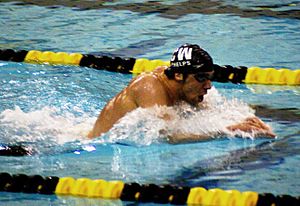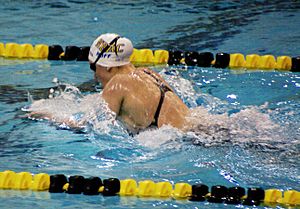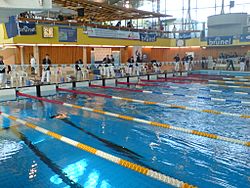Breaststroke facts for kids

Breaststroke is a swimming style in which the swimmer is on their chest and the torso does not rotate. It is the most popular recreational style due to the swimmer's head being out of the water a large portion of the time, and that it can be swum comfortably at slow speeds. In most swimming classes, beginners learn either the breaststroke or the front crawl first. However, at the competitive level, swimming breaststroke at speed requires comparable endurance and strength to other strokes. Some people refer to breaststroke as the "frog" stroke, as the arms and legs move somewhat like a frog swimming in the water. The stroke itself is the slowest of any competitive strokes and is thought to be the oldest of all swimming strokes.
Contents
Speed and ergonomics
Breaststroke is the slowest of the four official styles in competitive swimming. The fastest breaststrokers can swim about 1.70 metres per second. It is sometimes the hardest to teach to rising swimmers after butterfly due to the importance of timing and the coordination required to move the legs properly.
In the breaststroke, the swimmer leans on the chest, arms breaking the surface of the water slightly, legs always underwater and the head underwater for the second half of the stroke. The kick is sometimes referred to as a "frog kick" because of the resemblance to the movement of a frog's hind legs; however, when done correctly it is more of a "whip kick" due to the whip-like motion that moves starting at the core down through the legs.
The body is often at a steep angle to the forward movement, which slows down the swimmer more than any other style. Professional breaststrokers use abdominal muscles and hips to add extra power to the kick, although most do not perfect this technique until the collegiate level. This much faster form of breaststroke is referred to as "wave-action" breaststroke and fully incorporates the whip-kick.
A special feature of competitive breaststroke is the underwater pullout. From the streamline position, one uses the arms to pull all the way down past the hips. As the arms are pulling down, one downward dolphin kick is allowed (as of the 2005 season), though still optional; more than one dolphin kick will result in disqualification. This is followed by the recovery of the arms to the streamline position once more with a breaststroke kick. The pullout is also called the "pull down". The pullout at the start and after the turns contributes significantly to the swimming times. Open turns can be easily performed at the walls, but both hands must make contact with the wall. Therefore, one way to improve swimming times is to focus on the start and the turns.
Technique
The breaststroke starts with the swimmer lying in the water face down, arms extended straight forward and legs extended straight to the back.
Arm movement
There are three steps to the arm movement: outsweep, insweep, and recovery. The movement starts with the outsweep. From the streamline position, the palms turn out and the hands separate to slightly past shoulder width. The outsweep is followed by the insweep, where the hands point down and push the water backwards. The elbows stay in the horizontal plane through the shoulders. The hands push back until approximately the vertical plane through the shoulders. At the end of the insweep the hands come together with facing palms in front of the chest and the elbows are at the side at the body. In the recovery phase, the hands are moved forward again into the initial position under water. The entire arm stroke starts slowly, increases speed to the peak arm movement speed in the insweep phase, and slows down again during recovery. The goal is to produce maximum thrust during the insweep phase, and minimum drag during the recovery phase. Another variant is the underwater pull-down, similar to the push phase of a butterfly stroke. This stroke continues the insweep phase and pushes the hands all the way to the back to the sides of the hip. This greatly increases the push froAs a variant, it is possible to recover the arms over water. This reduces drag, but requires more power. Some competitive swimmers use this variant in competition.≤ m one stroke, but also makes recovery more difficult. This style is well suited for underwater swimming. However, FINA allows this stroke only for the first stroke after the start and each turn. In late 2005, FINA has also introduced a new rule which allows you to perform a single downward kick after the push off the wall.
Leg movement
The leg movement, colloquially known as the "frog kick" or "whip kick", consists of two phases: bringing the feet into position for the thrust phase and the insweep phase. From the initial position with the legs stretched out backward, the feet are moved together towards the posterior, while the knees stay together. The knees should not sink too low, as this increases the drag. Then the feet point outward in preparation for the thrust phase. In the thrust phase, the legs are moved elliptically back to the initial position. During this movement, the knees are kept together. The legs move slower while bringing the legs into position for the thrust phase, and move very fast during the thrust phase. Again, the goal is to produce maximum thrust during the insweep phase, and minimise drag during the recovery phase. In the recovery phase the lower leg and the feet are in the wake of the upper leg, and the feet are pointed to the rear. In the thrust phase all three parts create their own wake, and the flat end of the feet acts like a hydrofoil aligned to give maximum forward thrust. The resulting drag coefficient (or more precisely the frontal area) is thus doubled in the thrust phase.
A fit adult creates a wake. Drag due to a wake is Newtonian drag, increasing with the square of the velocity. For example, if the relative speed between the water and the leg is twice as high on the thrust phase than on the recovery phase, the thrust is four times as high as the drag. Assuming the legs are recovered with a relative speed between leg and body which amounts to the same as the relative speed between water and body, the legs must be kicked back with five times the mean velocity of the swimmer. This limits the top speed. Both effects together, velocity and frontal area, yield a thrust-to-drag ratio of 8 for the legs.
As a variant, some swimmers move the knees apart during the preparation phase and keep them apart until almost the end of the thrust phase. Moving both knee and foot outwards like a real frog avoids the extreme rotation in the lower leg.
All other variants fail to increase the frontal area, yet swimmers using them still generate some thrust by the velocity variation and do not drown. Another variant of the breaststroke kick is the scissor kick, however, this kick violates the rules of the FINA as it is no longer symmetrical. Swimming teachers put a great effort into steering the students away from the scissor kick. In the scissor kick, one leg moves as described above, but the other leg does not form an elliptical movement but merely an up-down movement similar to the flutter kick of front crawl. Some swimming teachers believe that learning the front crawl first gives a higher risk of an incorrect scissor kick when learning breaststroke afterwards.
Breaststroke can also be swum with the dolphin kick in butterfly, but this also violates the FINA rules. One kick is allowed, however, at the start and at the turn, providing that it is part of the body's natural movement.
The harmonic movements of the dolphin kick and flutter kick are in contrast to the breaststroke whip kick, which really deserves the name kick. Scissor kick and frog kick are intermediate. Humans have strong muscles in the legs and would need swim fins (like a frog) to bring all their power into the water and stand with the sole of the feet on the water. Rather the leg grabs almost as much water as the foot and a small amount of water is accelerated to high kinetic energy, but not much impulse is transferred. The toes are bent, the feet point 45° outwards, the sole points backwards, to mimic a hydrofoil. While closing in a V shape to the rear a small “lifting” force can be felt. Unlike in the other kicks, the joints are moved into extrema. Before the kick the knee is maximally bent and the upper leg is rotating along its axis to its extreme outer position and the lower leg is twisted to extreme, at the end of the kick the ankles are maximally turned to the inside so that the soles clap together to achieve a nozzle effect like in a jelly fish. Therefore, training involves getting flexible in addition to fitness and precision. The sudden sideways stress on knee at the kick can lead to uncomfortable noise and feeling for the beginner and to wear for the senior.
Breathing
The easiest way to breathe during breaststroke is to let the head follow the spine. When the swimmer's elbows have reached the line of his eye and have begun to rise, his head starts to lift. If he uses his high elbows as a hinge for the inward sweep of his hands and forearms, he will create the leverage he needs to use his abdominal muscles to bring his hips forward. When his hips move forward, his chest, shoulders and upper back will automatically lift up. Breathing is usually done during the beginning of the insweep phase of the arms, and the swimmer breathes in ideally through the mouth. The swimmer breathes out through mouth and nose during the recovery and gliding phase. Breaststroke can be swum faster if submerged completely, but FINA requires the head to break the surface once per cycle except for the first cycle after the start and each turn. Thus, competitive swimmers usually make one underwater pull-out, pushing the hands all the way to the back after the start and each turn.
Recreational swimmers often keep their head above water at all times when they swim breaststroke.
Body movement
The movement starts in the initial position with the body completely straight, body movement is coordinated such that the legs are ready for the thrust phase while the arms are halfway through the insweep, and the head is out of the water for breathing. In this position the body has also the largest angle to the horizontal. The arms are recovered during the thrust phase of the legs. After the stroke the body is kept in the initial position for some time to utilize the gliding phase. Depending on the distance and fitness the duration of this gliding phase varies. Usually the gliding phase is shorter during sprints than during long distance swimming. The gliding phase is also longer during the underwater stroke after the start and each turn. However, the gliding phase is usually the longest phase in one entire cycle of breaststroke.
Start
Breaststroke uses the regular start for swimming. Some swimmers use a variant called the frog start, where the legs are pulled forward sharply before being extended again quickly during the airborne phase of the start. After the start a gliding phase follows under water, followed by one underwater pulldown and dolphin kick, then one whip kick as the hands are recovered back to a streamline. This is known as the pull-out. The head must break the surface before the arms reach their widest point on the first stroke after the pull-out. The downward butterfly kick was legalized by FINA, WWF and the NCAA in 2005, and remains optional. The downward fly kick is now allowed in MCSL.
Turn and finish
For competitive swimming it is important that the wall at the end of the lane is always touched by both hands (known as a "Two-Hand Touch") at the same time due to FINA regulations.
The turn is initiated by touching the wall during the gliding or during the recovery phase of the arms, depending on how the wall can be touched faster. After touching the wall, the legs are pulled underneath of the body. The body turns sideways while one hand is moved forward (i.e. towards the head) along the side of the body. When the body is almost completely turned, the other hand will be swung straight up through the air such that both hands meet at the front at the same time. At that time the body should also be almost in the horizontal and partially or totally submerged. After the body is completely submerged, the body is pushed off the wall with both legs. Doing this under water will reduce the drag. After a gliding phase, an underwater pull-out is done, followed by another gliding phase and then regular swimming. The head must break the surface during the second stroke.
As a variant, some swimmers experiment with a flip over turn similar to front crawl.
The finish is similar to the touching of the wall during a turn.
Styles
The three main styles of breaststroke seen today are the conventional (flat), undulating, and wave-style. The undulating style is usually swum by extremely flexible swimmers, (e.g. Amanda Beard), and few people have the flexibility to accomplish it. The wave-style breaststroke was pioneered by Hungarian Swimming Coach Joseph Nagy. The breaststroke style was swum and made famous by Mike Barrowman when he set a world record using it, is now commonly swum by Olympians, though Australian swimmers, most prominently Leisel Jones, generally seem to shun it. Olympian Ed Moses still swims a more flat- style, despite the rapidly increasing popularity of the wave-style.
The wave-style breaststroke starts in a streamlined position, with shoulders shrugged to decrease drag in the water. While the conventional style is strongest at the outsweep, the wave-style puts much emphasis on the insweep, thus making the head rise later than in the conventional style. The wave-style pull is a circular motion with the hands accelerating to maximum speed and recovering in front of the chin, elbows staying at the surface and in front of the shoulders at all times. The high elbows creates the leverage for the powerful torso and abdominal muscles to assist in the stroke. During the insweep, the swimmer accelerates their hands and hollows their back and lifts themself out of the water to breathe. To visualize, some say that the hands anchor themselves in the water while the hips thrust forward.
The hollowed back and accelerating hands would lift the head out of the water. The head stays in a natural position, looking down and forward, and the swimmer inhales at this point. The feet retract to the bottom without moving the thigh, thus reducing resistance. The swimmer is at their highest point at this point.
Then the swimmer shrugs their shoulders and throws their arms and shoulders forward, lunging cat-like back into the water (though the emphasis is to go forward, not down). As the swimmer sinks, they arch their back, and kicks. Timing is very important in order for the kick to transfer all of its force via the arched back, but the optimum time is when the arms are 3/4 extended. Then the swimmer kicks and presses on their chest, undulating a little underwater, and squeezing the gluteus maximus to prevent the legs and feet from rising out of the water. The swimmer has now returned to the streamlined position, and the cycle starts again.
Incidentally, the wave motion should not be overly emphasized and the swimmer should only rise until the water reaches his biceps, instead of pushing his entire torso out of the water, wasting a great deal of energy.
Competitions
There are 8 common distances jumped in competitive breaststroke swimming, 4 in yards and 4 in meters. 25-yard pools are common in the United States and are routinely used in age group, high school and college competitions during the winter months.
- 25 yd Breaststroke (age group and club swimming for children 8 and under)
- 50 yd Breaststroke (age group swimming for children 12 and under)
- 100 yd Breaststroke
- 200 yd Breaststroke
25 meter or 50 meter pool distances
- 25 m Breaststroke (age group and club swimming for children 8 and under, 25 meter pool only, and not swum in year-around swimming)
- 50 m Breaststroke(age group and club swimming for children 12 and under)
- 100 m Breaststroke
- 200 m Breaststroke
Breaststroke is also part of the medley over the following distances:
- 100 yd Individual Medley
- 200 yd Individual Medley
- 400 yd Individual Medley
- 4 × 50 yd Medley Relay
- 4 × 100 yd Medley Relay
- 100 m Individual Medley (short 25 m pool only)
- 200 m Individual Medley
- 400 m Individual Medley
- 4 × 50 m Medley Relay
- 4 × 100 m Medley Relay
Occasionally other distances are swum on an ad hoc, unofficial basis (such as 400 yd breaststroke in some college dual meets).
See also
 In Spanish: Estilo braza para niños
In Spanish: Estilo braza para niños






